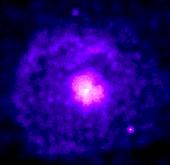 |
||
| First page | ||
 |
||
| Chandra | ||
 |
||
| Hubble Space Telescope | ||
 |
||
| Infrared Space Observatory | ||
 |
||
| Integral | ||
 |
||
| International Ultraviolet Explorer | ||
 |
Next Generation Space Telescope | |
 |
||
| XMM-Newton | ||
 |
||
| X-ray Timing Explorer | ||
 |
||
| Want to know more? | ||
 |
||
 |
||
The Chandra X-ray Observatory
(1999 - present)
When you look at the sky at night you may think that it looks uneventful, empty and colourless. You couldn't be more wrong.

When an X-ray telescope looks at the sky, the universe it sees is totally different - a violent, colourful, and ever-changing place. Temperatures can reach millions of degrees, objects can pass by with a speed close to that of light and strong magnetic fields make stars crack and tremble.
The Chandra X-ray Observatory, NASA's newest and most powerful x-ray telescope, was launched in July 1999. It will allow scientists from around the world to help understand the structure and evolution of the universe. Chandra will not only help to probe these mysteries, but also will serve as a unique tool to study detailed physics in the biggest possible laboratory; the Universe.
Chandra will provide unique and important information on everything from comets in our solar system to quasars at the edge of the observable universe. The observatory will help us find answers to questions such as:
* What and where is the "Dark Matter" in our universe?
* What is the powerhouse driving the explosive activity in many distant galaxies?
The Chandra X-ray Observatory in orbit
Chandra was carried into orbit by the Space Shuttle Columbia and was placed in a highly elliptical (oval-shaped) orbit. On it's way around the Earth it will be at an altitude spanning 6,000 to 86,400 miles, which means that at its highest point it is almost one-third of the way to the Moon. Due to this elliptical orbit, the observatory circles the Earth every 64 hours and takes 55 hours of uninterrupted observations during each orbit. The other 9 hours is when the observatory is too close to Earth's interfering radiation belts. This radiation is harmless to us but can overwhelm the observatory's sensitive instruments. This is also the reason we cannot have earth-based observatories for x-rays - they are absorbed by the Earth's atmosphere.
Chandra links
Chandra X-ray observatory (official homepage)
1st August 2000
Emma Button
Sarah Amandusson
www_astro@mssl.ucl.ac.uk